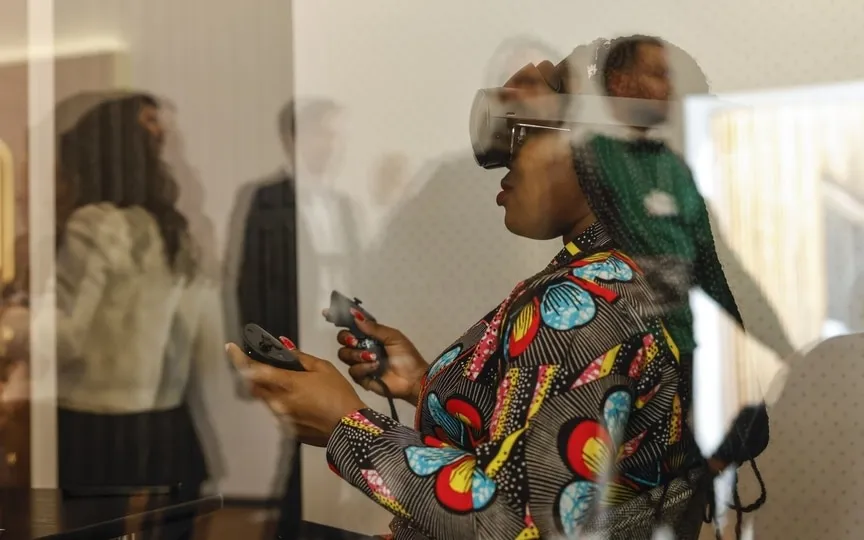What measures can parents take to ensure the safety of their children in the face of growing virtual reality grooming risks?
Adults and children are showing a growing interest in virtual reality (VR) headsets, which are becoming increasingly popular. These headsets are a component of extended reality environments that allow for more realistic and immersive experiences.
VR provides access to computer-generated 3D worlds and games in a variety of environments and interactions. Sometimes this is loosely referred to as the “metaverse”.
Most VR headsets have a minimum age limit of 10-13 years for safety reasons for augmented reality technologies in general and VR headsets in particular.
But VR is increasingly being used by young children, even preschoolers. These immersive technologies make it difficult to monitor children’s physical and emotional experiences and their interactions. What are the dangers and what can we do to ensure children’s safety?
Good and bad
VR allows children to dive into a digital world where they can immerse themselves in different characters (avatars). Due to the abundance of stimuli, VR can give the illusion of actually being in a virtual place – this is called “virtual presence”.
If the children then interact with other people in the virtual world, the psychological realism increases. These experiences can be fun and rewarding.
However, they can also have negative effects. Children tend to have a hard time distinguishing between what is happening in VR and the real world.
As children identify with their avatars, the line between them and the VR device blurs as they play in the metaverse.
Children can even develop traumatic memories while playing in virtual worlds. Due to the immersive nature of VR, the sense of presence gives the impression that the child’s avatar is truly “real”.
Research is still nascent, but it is known that children can form memories of virtual experiences, meaning that virtual sexual abuse can become a real traumatic memory.
The Rise of “Cyber Grooming”.
Research has shown that online predators use a variety of grooming strategies to manipulate children into sexual intercourse. This sometimes leads to offline encounters without parents knowing.
Non-threatening treatment strategies that build rapport are common. Makers can use friendship strategies to develop rapport with children and build trust. The child then sees the person as a reliable friend rather than a stranger. As a result, preventive messages about strangers learned through educational programs are ineffective in protecting children.
According to a recent meta-analysis, online sex offenders are usually acquaintances. Not surprisingly, some adult predators pretend to be peers (i.e. other children or teenagers).
Adult sexual approaches occur more often on platforms widely used by children. “Sexual communication with a child” offenses increased by 84% between 2017-2018 and 2021-22, according to UK police statistics.
Due to the hidden nature of cyberbullying, it is difficult to know the true prevalence of this problem. Some police reports in Europe show that about 20 percent of children have experienced sexual attraction online, and up to 25 percent of children reported having sexual contact with an adult online.
Europol’s reports show that children have been lured into erotic roleplay online. In interviews with researchers, some parents have also shared anecdotal experiences of their children’s exposure to overt sex on social online gaming platforms such as Roblox.
Such encounters can create memories as if the virtual experience had taken place in real life.
It is important for parents to know that cyber groomers are well versed in the use of very popular virtual worlds. They offer predators anonymity and easy access to children, where they can lure them into sex.
Parents need to try VR for themselves
A recent report by the charity Internet Watch Foundation says that a record number of young children have been manipulated into performing sexual acts online.
Through Metaverse, the sex offender can be brought virtually into the child’s bedroom and engage in sexual behavior through the child’s VR device. As VR worlds become more immersive, the danger to children only increases.
Treatment happens where parents least expect it to happen. To mitigate this risk, parents need to be aware of online treatment practices such as isolating the child, confiding in him and asking him to hide the relationship.
Early recognition of the signs can prevent abuse from happening. But this can be difficult if parents are not familiar with the technology their children are using.
To help them understand what their children are experiencing in augmented reality environments, parents need to familiarize themselves with VR and the metaverse.
If parents experience and try VR technology themselves, they can talk with their children about their experiences and understand who the child can interact with.
This allows parents to make informed decisions and implement customized protective measures. These safeguards include checking parental controls and security features on each platform, and actively learning what their children are playing and who they are interacting with.
With safety measures like these, parents can let their kids have fun with VR headsets while keeping them protected. (Talk) NSA NSA
Also read these top stories today:
Elon Musk’s Neuralink problems over? Well, Neuralink’s challenges are far from over. Implanting the device in a human is just the beginning of a decades-long clinical project fraught with competitors, financial obstacles and ethical dilemmas. Read all about it here. Was it interesting? Go ahead and share it with everyone you know.
Cyber criminals take down deep fake video scam! Fraudsters defrauded a multinational company of about $26 million by impersonating senior executives using deep-fake technology, Hong Kong police said Sunday, in one of the first such cases in the city. Find out how they did it here. If you enjoyed reading this article, please share it with your friends and family.
Facebook founder Mark Zuckerberg apologized to the families of children who were abused online. But it’s not enough. Here’s what US lawmakers need to force social media companies to do now. Dive here.




